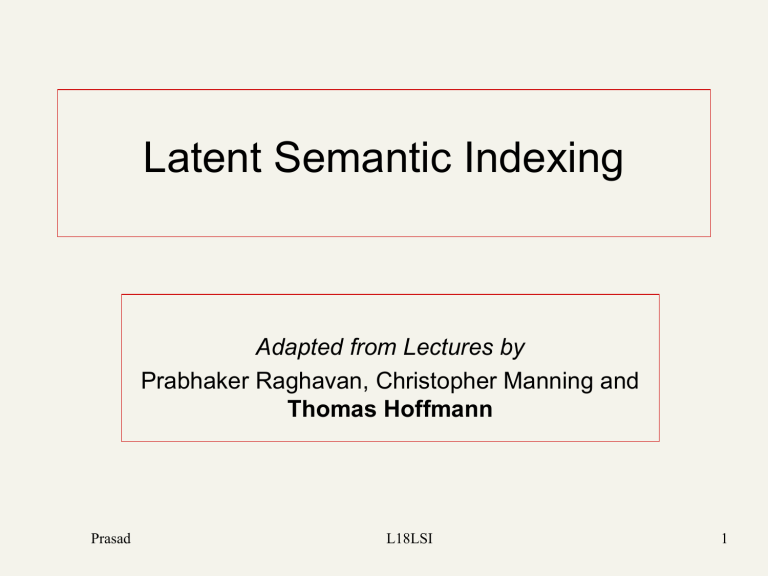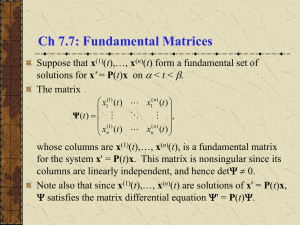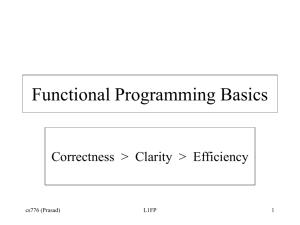A k

Latent Semantic Indexing
Prasad
Adapted from Lectures by
Prabhaker Raghavan, Christopher Manning and
Thomas Hoffmann
L18LSI 1
Today ’ s topic
Latent Semantic Indexing
Term-document matrices are very large
But the number of topics that people talk about is small (in some sense)
Clothes, movies, politics, …
Can we represent the term-document space by a lower dimensional latent space?
Prasad L18LSI 2
Prasad
Linear Algebra
Background
L18LSI 3
Eigenvalues & Eigenvectors
Eigenvectors (for a square m m matrix S )
Example
(right) eigenvector eigenvalue
How many eigenvalues are there at most?
only has a non-zero solution if this is a m -th order equation in λ which can have at most m distinct solutions (roots of the characteristic polynomial) – can be complex even though S is real.
4
Matrix-vector multiplication
S
30 0 0
0 20 0
0 0 1
has eigenvalues 30, 20, 1 with corresponding eigenvectors v
1
0
0
1
v
2
1
0
0
v
3
1
0
0
On each eigenvector, S acts as a multiple of the identity matrix: but as a different multiple on each.
Any vector (say x= ) can be viewed as a combination of
2
6
the eigenvectors: x = 2v
1
+ 4v
2
+ 6v
3
Matrix vector multiplication
Thus a matrix-vector multiplication such as Sx
( S , x as in the previous slide) can be rewritten in terms of the eigenvalues/eigenvectors:
Sx S (2 v
1
Sx 2 Sv
1
4 v
2
4 Sv
2
6 v
3
)
6 Sv
3
2
1 v
1
Sx 60 v
1
80 v
2
6 v
3
4
2 v
2
6
3 v
3
Even though x is an arbitrary vector, the action of S on x is determined by the eigenvalues/eigenvectors.
Prasad L18LSI 6
Matrix vector multiplication
Key Observation : the effect of “ small ” eigenvalues is small.
If we ignored the smallest eigenvalue (1), then instead of
60
80
6
we would get
60
80
0
Prasad
These vectors are similar (in terms of cosine similarity), or close (in terms of Euclidean distance).
L18LSI 7
Eigenvalues & Eigenvectors
Prasad eigenvalues are
distinct
{ { 1
All eigenvalues of a real symmetric matrix are
All eigenvalues of a positive semi-definite matrix are non-negative
,
8 L18LSI
Example
Let
Then
S
2
1
1
2
Real, symmetric.
(
The eigenvalues are 1 and 3 (nonnegative, real).
The eigenvectors are orthogonal (and real):
Prasad
1
1
1
1
Plug in these values and solve for eigenvectors.
Eigen/diagonal Decomposition
Let be a square matrix with m linearly independent eigenvectors (a “ non-defective ” matrix)
Theorem : There exists an eigen decomposition diagonal
(cf. matrix diagonalization theorem)
Unique for distinct eigenvalues
Columns of U are eigenvectors of S
Diagonal elements of are eigenvalues of
Prasad L18LSI 10
Diagonal decomposition: why/how
Let U have the eigenvectors as columns: U
v
1
Then, SU can be written
v n
...
v n
...
n
Thus SU=U
, or U
–1
SU=
And S=U
U
–1
.
Prasad 11
Diagonal decomposition - example
Recall S
2
1
1
2
;
1
1 ,
2
3 .
Inverting, we have U
1
1
1
1
/
/
2
2
1
/
2
U
1
1
Recall
UU –1 =1.
1
1
Then, S=U
U
–1
=
1
0
3
2 1
Example continued
Let ’ s divide U (and multiply U
–1
) by 2
Then, S=
Q
/
/
2
2
/
/
(Q -1 = Q T )
Why? Stay tuned …
L18LSI Prasad 13
Symmetric Eigen Decomposition
If is a symmetric matrix:
Theorem : There exists a (unique) eigen decomposition T
Q
where Q is orthogonal:
Q -1 = Q T
Columns of Q are normalized eigenvectors
Columns are orthogonal.
Prasad
(everything is real)
L18LSI 14
Exercise
Examine the symmetric eigen decomposition, if any, for each of the following matrices:
0
1 0
1
0
1
1
0
1
2 3
2
2
2
2
4
Prasad L18LSI 15
Time out!
I came to this class to learn about text retrieval and mining, not have my linear algebra past dredged up again …
But if you want to dredge, Strang ’ s Applied
Mathematics is a good place to start.
What do these matrices have to do with text?
Recall M
N termdocument matrices …
But everything so far needs square matrices – so
…
Prasad L18LSI 16
Singular Value Decomposition
For an M
N matrix
A of rank r there exists a factorization
(Singular Value Decomposition = SVD ) as follows:
T
V
M
M M
N
V is
N
N
The columns of U are orthogonal eigenvectors of AA T .
The columns of V are orthogonal eigenvectors of A T A .
Eigenvalues
1
… r
Prasad of AA T are the eigenvalues of A T A .
i
i
1
r
Singular values.
Singular Value Decomposition
Illustration of SVD dimensions and sparseness
Prasad L18LSI 18
SVD example
Let A
1
0
1
1 0
1
Thus M=3, N=2. Its SVD is
1
2 1
6
6
6
/
/
3
3
3
2
2
/
Typically, the singular values are arranged in decreasing order.
Low-rank Approximation
SVD can be used to compute optimal low-rank approximations .
Approximation problem : Find A k of rank k such that k min
A k and X are both m n matrices.
Typically, want k << r.
Prasad L18LSI 20
Low-rank Approximation
Solution via SVD
1
k
0 set smallest r-k singular values to zero k
A k i
1 i
T v i column notation: sum of rank 1 matrices
Reduced SVD
If we retain only k singular values, and set the rest to 0, then we don ’ t need the matrix parts in red.
Then Σ is k × k , U is M × k , V T is k × N , and A k
M × N.
is
This is referred to as the reduced SVD.
It is the convenient (space-saving) and usual form for computational applications.
k
22
Approximation error
How good (bad) is this approximation?
It ’ s the best possible, measured by the
Frobenius norm of the error:
where the
i
are ordered such that
i
i+1
.
Suggests why Frobenius error drops as k increases.
Prasad L18LSI 23
SVD Low-rank approximation
Whereas the term-doc matrix A may have
M= 50000, N= 10 million (and rank close to 50000)
We can construct an approximation A
100 with rank 100.
Of all rank 100 matrices, it would have the lowest
Frobenius error.
Great … but why would we??
Answer: Latent Semantic Indexing
C. Eckart, G. Young, The approximation of a matrix by another of lower rank.
Psychometrika, 1, 211-218, 1936.
Prasad
Latent Semantic
Indexing via the SVD
L18LSI 25
What it is
From term-doc matrix A, we compute the approximation A k.
There is a row for each term and a column for each doc in A k
Thus docs live in a space of k<<r dimensions
These dimensions are not the original axes
But why?
Prasad L18LSI 26
Vector Space Model: Pros
Automatic selection of index terms
Partial matching of queries and documents
(dealing with the case where no document contains all search terms)
Ranking according to similarity score (dealing with large result sets)
Term weighting schemes (improves retrieval performance)
Various extensions
Document clustering
Relevance feedback (modifying query vector)
Geometric foundation
Prasad L18LSI 27
Problems with Lexical Semantics
Ambiguity and association in natural language
Polysemy : Words often have a multitude of meanings and different types of usage
(more severe in very heterogeneous collections).
The vector space model is unable to discriminate between different meanings of the same word.
Prasad 28
Problems with Lexical Semantics
Synonymy : Different terms may have identical or similar meanings
(weaker: words indicating the same topic).
No associations between words are made in the vector space representation.
Prasad L18LSI 29
Polysemy and Context
Document similarity on single word level: polysemy and context meaning 1 ring jupiter
••• space voyager
… …
Prasad contribution to similarity, if used in 1 st meaning, but not if in 2 nd
L18LSI meaning 2 car company
••• dodge ford
30
Latent Semantic Indexing (LSI)
Perform a low-rank approximation of document-term matrix (typical rank 100-300 )
General idea
Map documents ( and terms) to a lowdimensional representation.
Design a mapping such that the low-dimensional space reflects semantic associations (latent semantic space).
Compute document similarity based on the inner product in this latent semantic space
Prasad L18LSI 31
Goals of LSI
Similar terms map to similar location in low dimensional space
Noise reduction by dimension reduction
Prasad L18LSI 32
Latent Semantic Analysis
Latent semantic space : illustrating example
Prasad L18LSI courtesy of Susan Dumais
33
Performing the maps
Each row and column of A gets mapped into the k -dimensional LSI space, by the SVD.
Claim – this is not only the mapping with the best
(Frobenius error) approximation to A , but in fact improves retrieval.
A query q is also mapped into this space, by q k q
k k
Query NOT a sparse vector.
Prasad L18LSI 34
Performing the maps
A T A is the dot product of pairs of documents
A T A ≈ A k
T A k
= ( U k
k
V k
T ) T ( U k
k
V k
T )
= V k
k
U k
T U k
k
V k
T
= ( V k
k
) ( V k
k
) T
Since V k
= A k
T U k
k
-1 we should transform query q to q k as follows q k
q T U k
1 k
Sec. 18.4
35
Empirical evidence
Experiments on TREC 1/2/3 – Dumais
Lanczos SVD code (available on netlib) due to Berry used in these expts
Running times of ~ one day on tens of thousands of docs [still an obstacle to use]
Dimensions – various values 250-350 reported. Reducing k improves recall.
(Under 200 reported unsatisfactory)
Generally expect recall to improve – what about precision?
L18LSI 36
Empirical evidence
Precision at or above median TREC precision
Top scorer on almost 20% of TREC topics
Slightly better on average than straight vector spaces
Effect of dimensionality:
Prasad L18LSI
Dimensions Precision
250 0.367
300
346
0.371
0.374
37
But why is this clustering?
We ’ ve talked about docs, queries, retrieval and precision here.
What does this have to do with clustering?
Intuition : Dimension reduction through LSI brings together “ related ” axes in the vector space.
Prasad L18LSI 39
Intuition from block matrices
M terms
Prasad
Block 1
0 ’ s
N documents
What ’ s the rank of this matrix?
Block 2
0 ’ s
…
Block k
= Homogeneous non-zero blocks.
Intuition from block matrices
N documents
Block 1
Block 2
0 ’ s
M terms
…
0 ’ s
Block k
Vocabulary partitioned into k topics (clusters); each doc discusses only one topic.
Intuition from block matrices
Likely there ’ s a good rank-k approximation to this matrix.
wiper tire
V6
Block 1
Few nonzero entries
Block 2
Few nonzero entries
…
Block k car automobile
1
0
0
1
Simplistic picture
Topic 1
Topic 2
Prasad Topic 3 43
Some wild extrapolation
The “ dimensionality ” of a corpus is the number of distinct topics represented in it.
More mathematical wild extrapolation:
if A has a rank k approximation of low
Frobenius error, then there are no more than k distinct topics in the corpus.
Prasad L18LSI 44
LSI has many other applications
In many settings in pattern recognition and retrieval, we have a feature-object matrix.
For text, the terms are features and the docs are objects.
Could be opinions and users …
This matrix may be redundant in dimensionality.
Can work with low-rank approximation.
If entries are missing (e.g., users ’ opinions), can recover if dimensionality is low.
Powerful general analytical technique
Prasad
Close, principled analog to clustering methods.
45
46
Hinrich Schütze and Christina Lioma
Latent Semantic Indexing
Overview
❶
Latent semantic indexing
❷
Dimensionality reduction
❸
LSI in information retrieval
47
Outline
❶
Latent semantic indexing
❷
Dimensionality reduction
❸
LSI in information retrieval
48
Recall: Term-document matrix
Anthony and
Cleopatra
Julius
Caesar
The
Tempest
Hamlet Othello anthony 5.25
brutus 1.21
caesar 8.59
calpurnia 0.0
3.18
6.10
2.54
1.54
0.0
0.0
0.0
0.0
0.0
1.0
1.51
0.0
0.0
0.0
0.25
0.0
Macbeth
0.35
0.0
0.0
0.0
0.0
cleopatra 2.85
0.0
0.0
0.0
0.0
mercy worser
1.51
1.37
0.0
0.0
1.90
0.11
0.12
4.15
5.25
0.25
0.88
1.95
This matrix is the basis for computing the similarity between documents and queries . Today: Can we transform this matrix, so that we get a better measure of similarity between documents and queries? . . .
49
Latent semantic indexing: Overview
We decompose the term-document matrix into a product of matrices.
The particular decomposition we ’ ll use is: singular value decomposition (SVD).
SVD: C = U Σ V T (where C = term-document matrix)
We will then use the SVD to compute a new, improved termdocument matrix C ′.
We ’ ll get better similarity values out of C ′ (compared to C ).
Using SVD for this purpose is called latent semantic indexing or LSI.
50
Example of C = U Σ V T : The matrix C
This is a standard term-document matrix. Actually, we use a non-weighted matrix here to simplify the example.
51
Example of C = U Σ V T : The matrix U
One row per term, one column per min( M , N ) where M is the number of terms and N is the number of documents. This is an orthonormal matrix :
(i) Row vectors have unit length. (ii) Any two distinct row vectors are orthogonal to each other. Think of the dimensions (columns) as
“ semantic ” dimensions that capture distinct topics like politics, sports, economics. Each number u ij in the matrix indicates how strongly related term i is to the topic represented by semantic dimension j .
52
Example of C = U Σ V T : The matrix Σ
This is a square, diagonal matrix of dimensionality min( M , N )
× min( M , N ). The diagonal consists of the singular values of
C . The magnitude of the singular value measures the importance of the corresponding semantic dimension . We ’ ll make use of this by omitting unimportant dimensions.
53
Example of C = U Σ V T : The matrix V T
One column per document, one row per min( M , N ) where M is the number of terms and N is the number of documents.
Again: This is an orthonormal matrix : (i) Column vectors have unit length. (ii) Any two distinct column vectors are orthogonal to each other. These are again the semantic dimensions from the term matrix U that capture distinct topics like politics, sports, economics. Each number v ij in the matrix indicates how strongly related document i is to the topic represented by semantic dimension j .
54
Example of C = U Σ V T : All four matrices
55
55
LSI: Summary
We ’ ve decomposed the term-document matrix C into a product of three matrices.
The term matrix U – consists of one (row) vector for each term
The document matrix V T – consists of one (column) vector for each document
The singular value matrix Σ – diagonal matrix with singular values, reflecting importance of each dimension
Next: Why are we doing this?
56
56
Outline
❶
Latent semantic indexing
❷
Dimensionality reduction
❸
LSI in information retrieval
57
How we use the SVD in LSI
Key property: Each singular value tells us how important its dimension is.
By setting less important dimensions to zero, we keep the important information, but get rid of the
“ details ” .
These details may
be noise – in that case, reduced LSI is a better representation because it is less noisy.
make things dissimilar that should be similar
– again reduced LSI is a better representation because it represents similarity better.
58
How we use the SVD in LSI
Analogy for “ fewer details is better ”
Image of a bright red flower
Image of a black and white flower
Omitting color makes it easier to see similarity
59
Recall unreduced decomposition C = U Σ V T
60
60
Reducing the dimensionality to 2
61
61
Reducing the dimensionality to 2
62
Actually, we only zero out singular values in Σ . This has the effect of setting the corresponding dimensions in
U and V T to zero when computing the product
C = U Σ V T .
62
Original matrix C vs. reduced C
2
= U Σ
2
V T
We can view
C
2 as a twodimensional representation of the matrix.
We have performed a dimensionality reduction to two dimensions.
63
63
Why is the reduced matrix “better”
Similarity of d2 and d3 in the original space: 0.
Similarity of d2 and d3 in the reduced space:
0.52 * 0.28 + 0.36 *
0.16 + 0.72 * 0.36 +
0.12 * 0.20 + - 0.39 *
- 0.08 ≈ 0.52
64
64
Why the reduced matrix is “better”
“ boat ” and “ ship ” are semantically similar.
The “ reduced ” similarity measure reflects this.
What property of the
SVD reduction is responsible for improved similarity?
65
65
Another Contrived Example
Illustrating SVD
Prasad
(1) Two clean clusters
(2) Perturbed matrix
(3) After dimension reduction
L18LSI 66
Term Document Matrix : Two Clusters
Prasad L18LSI 67
Term Document Matrix : Disjoint vocabulary clusters
D =
1 1 1 0 0
1 1 0 0 0
0 1 1 0 0
0 0 0 1 1
0 0 0 0 1
Prasad L18LSI 68
Term Document Matrix : Disjoint vocabulary clusters
Prasad L18LSI 69
Term Document Matrix : Perturbed (Doc 3)
Prasad L18LSI 70
Term Document Matrix :
Recreated Approximation
Prasad L18LSI 71
Outline
❶
Latent semantic indexing
❷
Dimensionality reduction
❸
LSI in information retrieval
72
Why we use LSI in information retrieval
LSI takes documents that are semantically similar (= talk about the same topics), . . .
. . . but are not similar in the vector space (because they use different words) . . .
. . . and re-represent them in a reduced vector space . .
. . . in which they have higher similarity.
Thus, LSI addresses the problems of synonymy and semantic relatedness .
Standard vector space: Synonyms contribute nothing to document similarity.
Desired effect of LSI: Synonyms contribute strongly to document similarity.
73
How LSI addresses synonymy and semantic relatedness
The dimensionality reduction forces us to omit “details”.
We have to map different words (= different dimensions of the full space) to the same dimension in the reduced space.
The “ cost ” of mapping synonyms to the same dimension is much less than the cost of collapsing unrelated words.
SVD selects the “ least costly ” mapping (see below).
Thus, it will map synonyms to the same dimension.
But, it will avoid doing that for unrelated words.
74
74
LSI: Comparison to other approaches
Recap: Relevance feedback and query expansion are used to increase recall in IR – if query and documents have (in the extreme case) no terms in common.
LSI increases recall and can hurt precision .
Thus, it addresses the same problems as (pseudo) relevance feedback and query expansion . . .
. . . and it has the same problems.
75
75
Implementation
Compute SVD of term-document matrix
Reduce the space and compute reduced document representations
Map the query into the reduced space
This follows from:
Compute similarity of q
2
V
2
.
with all reduced documents in
Output ranked list of documents as usual
Exercise: What is the fundamental problem with this approach?
76
Optimality
SVD is optimal in the following sense.
Keeping the k largest singular values and setting all others to zero gives you the optimal approximation of the original matrix C . Eckart-Young theorem
Optimal: no other matrix of the same rank (= with the same underlying dimensionality) approximates C better.
Measure of approximation is Frobenius norm:
So LSI uses the “ best possible ” matrix.
Caveat: There is only a tenuous relationship between the
Frobenius norm and cosine similarity between documents.
77
Prasad
Example from Dumais et al
L18LSI 78
Latent Semantic Indexing (LSI)
Prasad L18LSI 80
Prasad L18LSI 81
Reduced Model (K = 2)
Prasad L18LSI 82
Prasad L18LSI 83
LSI, SVD, & Eigenvectors
SVD decomposes:
Term x Document matrix X as
X=U
V T
Where U,V left and right singular vector matrices, and
is a diagonal matrix of singular values
Corresponds to eigenvector-eigenvalue decompostion:
Z1=ULU T Z2=VLV T
Where U, V are orthonormal and L is diagonal
U: matrix of eigenvectors of Z1=XX T
V: matrix of eigenvectors of Z2=X T X
: diagonal matrix L of eigenvalues







